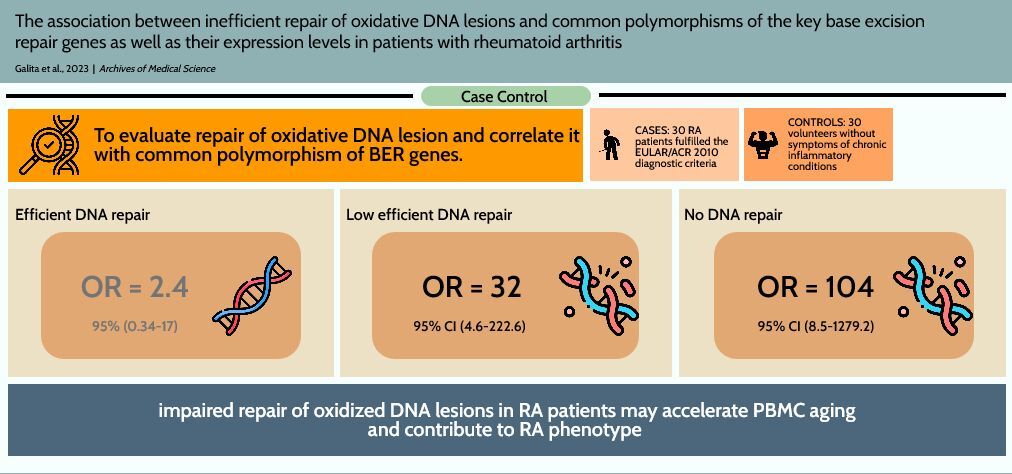Current issue
Archive
Manuscripts accepted
About the Journal
Editorial office
Editorial board
Section Editors
Abstracting and indexing
Subscription
Contact
Ethical standards and procedures
Most read articles
Instructions for authors
Article Processing Charge (APC)
Regulations of paying article processing charge (APC)
RHEUMATOLOGY / RESEARCH PAPER
The association between inefficient repair of oxidative DNA lesions and common polymorphisms of the key base excision repair genes as well as their expression levels in patients with Rheumatoid Arthritis
1
Medical University of Lodz, Poland
2
National Geriatrics, Rheumatology and Rehabilitation Institute, Poland
Submission date: 2022-09-19
Final revision date: 2023-02-24
Acceptance date: 2023-04-09
Online publication date: 2023-05-04
KEYWORDS
TOPICS
ABSTRACT
Introduction:
RA is a common autoimmune heterogeneous joint disease of still unknown etiology. One of the characteristic features of RA is oxidative stress, most probably induced and stimulated by inappropriate B and T-cell activity. We have hypothesized, that oxidative stress together with impaired DNA damage response to oxidative DNA lesions could be responsible for increased incidence in RA patients of some diseases with genetic instability background such as lymphoma.
Material and methods:
We determined the level of oxidative DNA lesions and the kinetics of removal of DNA damage induced by TBH in PBMCs of 30 RA patients and 30 healthy individuals. The metrics from DNA repair study were correlated with genotypes of common polymorphisms of key BER genes as well as their expression levels. DNA repair were evaluated by comet assay, the genotypes of the polymorphism were determined by Taqman Assay and PrimeTime qPCR Assay was used to analyze the expression profile of genes related to BER.
Results:
We observed an association between RA occurrences and impaired DNA repair in PBMCs. After dividing the subjects by controls’ quartiles of DNA repair efficiency, we found an association between an increased risk of RA and inefficient DNA Repair. We also identified interaction between inefficient DNA Repair and polymorphism of the UNG gene (rs246079), and lower expression of key BER genes – MUTH, NEIL3 and UNG.
Conclusions:
Our result suggest that the genetic variations within BER genes as well as epigenetic factors may be linked with RA by the modulation of the cellular response to oxidative stress.
RA is a common autoimmune heterogeneous joint disease of still unknown etiology. One of the characteristic features of RA is oxidative stress, most probably induced and stimulated by inappropriate B and T-cell activity. We have hypothesized, that oxidative stress together with impaired DNA damage response to oxidative DNA lesions could be responsible for increased incidence in RA patients of some diseases with genetic instability background such as lymphoma.
Material and methods:
We determined the level of oxidative DNA lesions and the kinetics of removal of DNA damage induced by TBH in PBMCs of 30 RA patients and 30 healthy individuals. The metrics from DNA repair study were correlated with genotypes of common polymorphisms of key BER genes as well as their expression levels. DNA repair were evaluated by comet assay, the genotypes of the polymorphism were determined by Taqman Assay and PrimeTime qPCR Assay was used to analyze the expression profile of genes related to BER.
Results:
We observed an association between RA occurrences and impaired DNA repair in PBMCs. After dividing the subjects by controls’ quartiles of DNA repair efficiency, we found an association between an increased risk of RA and inefficient DNA Repair. We also identified interaction between inefficient DNA Repair and polymorphism of the UNG gene (rs246079), and lower expression of key BER genes – MUTH, NEIL3 and UNG.
Conclusions:
Our result suggest that the genetic variations within BER genes as well as epigenetic factors may be linked with RA by the modulation of the cellular response to oxidative stress.
Share
RELATED ARTICLE
We process personal data collected when visiting the website. The function of obtaining information about users and their behavior is carried out by voluntarily entered information in forms and saving cookies in end devices. Data, including cookies, are used to provide services, improve the user experience and to analyze the traffic in accordance with the Privacy policy. Data are also collected and processed by Google Analytics tool (more).
You can change cookies settings in your browser. Restricted use of cookies in the browser configuration may affect some functionalities of the website.
You can change cookies settings in your browser. Restricted use of cookies in the browser configuration may affect some functionalities of the website.



